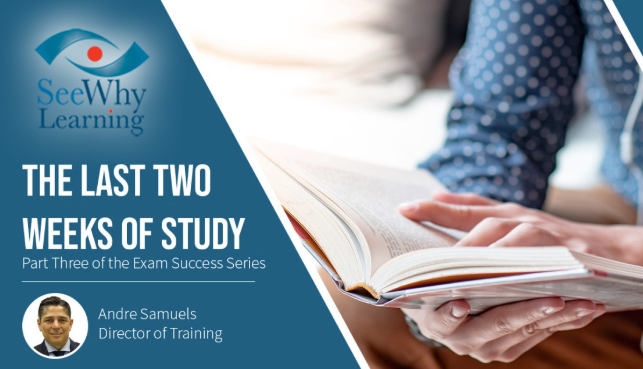When making commitments, keep in mind that you control only the input, not necessarily the outcome. For example, committing to study 10 hours per week and to write your exam in 60 days is completely within your control. However, a commitment to score 80% or more is not. You have no control over the difficulty of the exam. That being said, the appropriate input usually yields the desired result. If you commit to something within your control, the only one standing in your way is you. This also means that whatever it is that you are committing to is genuinely achievable.
If you’re following the advice in this blog series, you would have already booked your exam and told others about your commitment to recruit accountability partners. This week, I’m going to discuss the most critical phase of your studies, which is the last two weeks prior to exam day. At this point, stop reading the textbook or even the SeeWhy Learning study guide. This piece of advice may surprise you, so let me explain it a little further.
In a recent article titled “What’s Your Company’s Spread?,” I talked about the diversity of our team. Let me share a mildly embarrassing conversation I had with one of my younger colleagues when she used the acronym YOLO, a term I had never heard before. I didn’t even know it was an acronym. When I said, “What’s that?,” the whole room chuckled. Someone repeated the term YOLO. Another spelled it out: Y-O-L-O. It seemed the more they repeated themselves, the more confused I became, and the less likely I was going to get it.
This is what will happen if you keep rereading the textbook. It isn’t an efficient use of your time to hope something new is going to jump off the page at you. It’s like trying find a needle in a haystack. In fact, at this point in your studies, I recommend you write the word “dictionary” on the front cover as a constant reminder. Instead of reading it like a book, use it like a dictionary. In other words, use it to look up information you don’t know. You may be thinking, “Well, how do I know what I don’t know?” Simply put, you need to practice. Do many practice questions, and if you get a question correct, it will reinforce and help you retain your knowledge. If you get a question wrong, it represents a learning opportunity. If you’re working with the SeeWhy Learning questions, you’ll be provided with an easy-to-understand rationale after every single question. If the lightbulb still doesn’t go on, that’s when you’re going to pull out your “dictionary” and learn the concept you didn’t know. Then, get right back to doing questions.
For example, pretend my colleague asked me, “What does YOLO stand for?” The answer might be one of the following:
a) That’s a low blow.
b) You’re shady.
c) You only live once.
d) You’re vertically challenged.
If I guessed “you’re vertically challenged,” but the answer key explained that it’s an acronym for “you only live once,” I would have learned something new. In other words, I learned from my incorrect answer. If you follow this process to excess over the next two weeks, you’ll be amazed how much you’ll learn.
In next week’s blog, we’re going to discuss what to do on exam day.

